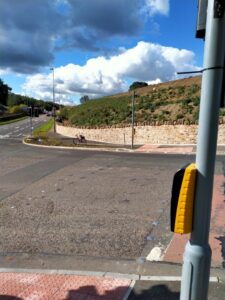A Living Streets Edinburgh volunteer paid a detailed visit to this junction following social media reports. She described it as “one of the worse junctions I’ve seen. Truly shocking, and feels unsafe to walk across.
Pedestrian is vulnerable crossing three lanes of traffic with vehicles passing close by at up to 40mph. I would avoid using this crossing, and it would be especially risky for slower walkers, eg. with children, wheelchairs, sight impairment, or elderly, etc.”
Summary:
• Inadequate green man illumination (7 seconds).
• Wide splay, no islands, cyclists swirling along pavement.
• Small crossing signals, poorly positioned and difficult to see.
• Absence or invisibility of road sign for change of speed limit.
• Two cars observed speeding through crossing while woman was walking on Green Man phase.
Details:
Old Dalkeith Road (A7) / The Wisp
Traffic signals
Not automated
No audio (beeps)
Tactile cones – present and workoing
Max waiting time for GM: 59 seconds
Length of GM phase: 7 seconds
Date Fri 23/9/22
Time 12.30
Description:
This is a busy junction designed to ease vehicle flow, not protect pedestrians. The Wisp runs north-south onto Old Dalkeith Road which is in west – east direction (before bending south). There are two lanes of traffic both ways on Old Dalkeith Road travelling at 40mph. It is a complex traffic light system with filters for different traffic lanes going straight ahead or turning.
The speed limit changes at the junction, from 40mph on Old Dalkeith Road, to 30mph on The Wisp. There is a 30mph sign visible to vehicles turning right into The Wisp from east side of junction, but no sign is visible to vehicles turning in from the west. Without visible signage, vehicles turning left into The Wisp may continue to drive at 40mph in the 30mph zone past Danderhall village.
I’ve reported this speed signage problem to CEC and to Midlothian Council (as the junction is on the border).
Junction is splayed wide and traffic turns corner at 40mph.
There are two pedestrian crossings, operating separately from each other – south end of The Wisp, and Old Dalkeith Road at east side of junction. Both crossings span three traffic lanes with no islands offering protection. Pedestrian road markings are not easily visible, camouflaged by colour of road.
People must ‘cross with traffic’ which feels dangerous while vehicles alongside are moving through filter lights.
The new pavement on the west side of The Wisp is extra wide -maybe it is for shared use with bicycles? There are no signs on the pavement, but the pedestrian crossing includes cycle lights. Cyclists were observed using the pavement. (Not surprised – cycling on the road here would be hazardous or frightening, given the multiple traffic lanes and high speeds.)
There is a new housing estate under construction to the north-west of the junction.
The bus stop on the south side of Old Dalkeith Road is accessible only via the pedestrian crossing.
The crossing light for pedestrians is mounted at waist height and faces in the direction of the road, not the pedestrian’s crossing route, so the GM on the far side is not visible when walking across.
The GM is illuminated for only 7 seconds and changes to red before people have crossed the road, even when walking quickly.
By the time the pedestrian light on the far side becomes visible, it has changed to red, which is alarming since you have no way of knowing how long before traffic starts to move again.
Together with vehicles moving through the junction alongside while GM is illuminated, the pedestrian feels feels vulnerable and insecure.
Total cycle time varied from 1 minute to 1 min 45 sec, so the GM appearance was unpredictable. There are no beeps, and the pedestrian crossing light is small and poorly positioned, so it is easy to miss the change from red to green, and then have to wait another minute or more. It is also possible to miss the GM phase because it is so short, especially if watching the traffic to gauge when the lights will change.
I saw a person crossing without waiting for GM light, which is very risky because of unpredictable traffic flow from traffic filter lanes.
In one phase I saw two cars drive fast through the green man while a woman was crossing The Wisp. She was visibly shaken. She was on The Wisp crossing and the cars were turning left into The Wisp from Old Dalkeith Road (west) where traffic was moving at 40mph.
Either the drivers deliberately drove through their light on red, or they were confused by the filter lights (which were red for left but green for ahead). The cars went through the crossing a long time after the GM appeared, as the woman was already half way across.
Spoke to two women with pushchairs who were obviously frustrated with this crossing. They said it had been installed quite recently. The previous system had both pedestrian crossings green at the same time, and all traffic stopped at once, which felt safer as pedestrians could cross without vehicle movement. They miss the audio beeps that have disappeared.
The women were very glad to speak as they feel ignored by council and road planners.
Photos attempt to show poor visibility of pedestrian lights, and wide splay of roads at junction.



